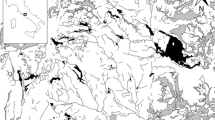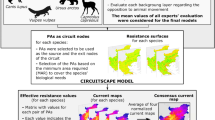Abstract
Context
Wild medium-sized ungulate populations are recovering in many countries of the Northern Hemisphere due to abandonment of rural areas but also due to the translocation of native and exotic ungulates for game hunting.
Objectives
To assess the role of landscape connectivity, habitat suitability and interspecific interactions driving the simultaneous range expansion of two wild ungulates, one native (Iberian ibex, Capra pyrenaica) and one exotic species (Barbary sheep, Ammotragus lervia), in southeastern Spain.
Methods
We reconstructed the expansion process of the Iberian ibex and the Barbary sheep in southeastern Spain for the period 1975–2009 by means of Local Ecological Knowledge and tested the role of habitat suitability, landscape connectivity and interspecific competition during the expansion process by means of GLMM. Habitat suitability was assessed by means of ecological niche modeling and landscape connectivity was represented by competing resistance surface dispersal models.
Results
Our results show that at the landscape scale both species are ecologically very similar, although the Iberian ibex is more specialized in less transformed landscapes. Landscape connectivity was the main driver of the colonization process, followed by habitat suitability. From a connectivity point of view, both species showed a coarse perception of the landscape, recognizing three main use types: natural, agricultural and human. Major linear infrastructures do not affect the colonization process. Our colonization models also suggest a negative interaction of the Iberian ibex on the Barbary sheep.
Conclusions
The exotic Barbary sheep and the native Iberian ibex are two ungulate species very similar ecologically whose simultaneous expansion process in southeastern Spain are driven by landscape connectivity followed by habitat suitability. In addition, the Iberian ibex affects negatively the colonization ability of the Barbary sheep. Overall, our work deepens our understanding on two pressing issues simultaneously: (i) controls of the range expansion of ungulates at the landscape scale and (ii) how a native and an introduced species interact during their expansion process.




Similar content being viewed by others
References
Acevedo P, Cassinello J (2009) Biology, ecology and status of Iberian ibex Capra pyrenaica: a critical review and research prospectus. Mamm Rev 39:17–32
Acevedo P, Cassinello J, Hortal J, Gortazar C (2007) Invasive exotic aoudad (Ammotragus lervia) as a major threat to native Iberian ibex (Capra pyrenaica): a habitat suitability model approach. Divers Distrib 13:587–597
Acevedo P, Delibes-Mateos M, Escudero A, Vicente J, Marco J, Gortazar C (2005) Environmental constraints in the colonization sequence of roe deer (Capreolus capreolus Linnaeus, 1758) across the Iberian Mountains, Spain. J Biogeogr 32:1671–1680
Adriaensen F, Chardon JP, De Blust G, Swinnen E, Villalba S, Gulinck H, Matthysen E (2003) The application of ‘least-cost’ modelling as a functional landscape model. Landsc Urban Plan 64:233–247
Anadón JD, Giménez A, Ballestar R, Perez I (2009) Evaluation of local ecological knowledge as a method for collecting extensive animal abundance data. Conserv Biol 23:617–625
Barton K (2015) MuMIn: multi-model inference. R package version 1(13):4
Bates D, Maechler M, Bolker B, Walker S (2014) _lme4: linear mixed-effects models using Eigen and S4_. R package version 1.1-7
Blázquez M, Sánchez-Zapata JA, Botella F, Carrete M, Eguia S (2009) Spatio-temporal segregation of facultative avian scavengers at ungulate carcasses. Acta Oecol 35:645–650
Burnham KP, Anderson DR (1998) Model selection and inference. Springer, New York
Carrete M, Sánchez-Zapata JA, Calvo JF, Lande R (2005) Demography and habitat availability in territorial occupancy of two coexisting species. Oikos 108:125–136
Cassinello J (1998) Ammotragus lervia: a review on systematics, biology, ecology and distribution. Ann Zool Fenn 35:149–162
Cassinello J, Acevedo P, Hortal J (2006) Prospects for population expansion of the exotic aoudad (Ammotragus lervia; Bovidae) in the Iberian Peninsula: clues from habitat suitability modelling. Divers Distrib 12:666–678
Cheeson P (2000) Mechanisms of maintenance of species diversity. Annu Rev Ecol Syst 31:343–366
Clavero M, García-Berthou E (2005) Invasive species are a leading cause of animal extinctions. Trends Ecol Evol 20:110
Davis A, Wagner JR (2003) Who Knows? On the importance of identifying “experts” when researching local ecological knwoledge. Hum Ecol 31:463–489
Di Marco M, Biotani L, Mallon D, Hoffmann M, Iacucci A, Meijaard E, Visconti P, Schipper J, Rondinini C (2014) A retrospective evaluation of the global decline of carnivores and ungulates. Conserv Biol 28:1109–1118
Fahrig L (2007) Non-optimal animal movement in human-altered landscapes. Funct Ecol 21:1003–1015
González-Candela M, Leon-Vizcaino L, Cubero-Pablo MJ (2004) Population effects of sarcoptic mange in Barbary sheep (Ammotragus lervia) from Sierra Espuña Regional Park, Spain. J Wildl Dis 40:456–465
Goodman LA (1961) Snowball sampling. Ann Math Stat 32:148–170
Guisan A, Zimmermann NE (2000) Predictive habitat distribution models in ecology. Ecol Model 135:147–186
Hill JK, Collingham YZ, Thomas CD, Blakeley DS, Fox R, Moss D, Huntley B (2001) Impacts of landscape structure on butterfly range expansion. Ecol Lett 4:313–321
Human KG, Gordon DM (1996) Exploitation and interference competition between the invasive Argentine ant, Linepithema humile, and native ant species. Oecologia 105:405–412
Huntington HP (1998) Observations on the utility of semi directive interviewing for documenting traditional ecological knowledge. Arctic 51:237–242
Kissling WD, Dormann CF, Groeneveld J, Hickler T, Kühn I, McInerny GJ, Montoya JM, Römermann C, Schiffers K, Schurr FM, Singer A (2012) Towards novel approaches to modelling biotic interactions in multispecies assemblages at large spatial extents. J Biogeogr 39:2163–2178
Kronfeld-Schor N, Dayan T (2003) Partitioning of time as an ecological resource. Annu Rev Ecol Evol Syst 34(153):153S
La Morgia V, Malenotti E, Badino G, Bona F (2011) Where do we go from here? Dispersal simulations shed light on the role of landscape structure in determining animal redistribution after reintroduction. Landscape Ecol 26:969–981
Nakagawa S, Schielzeth H (2013) A general and simple method for obtaining R2 from generalized linear mixed-effects models. Methods Ecol Evol 4:133–142
Navarro ML, Pereira HM (2012) Rewilding abandoned landscapes in Europe. Ecosystems 15:900–912
Núñez MA, Bailey JK, Schweitzer JA (2010) Population, community and ecosystem effects of exotic herbivores: a growing global concern. Biol Invasions 12:297–301
Peterson AT, Soberón J, Pearson RG, Anderson RP, Martínez-Meyer E, Nakamura M, Araújo MB (2011) Ecological niches and geographic distributions. Princeton University Press, Princeton
Phillips SJ, Anderson RP, Schapire RE (2006) Maximum entropy modeling of species geographic distributions. Ecol Model 190:231–259
Phillips SJ, Dudík M (2008) Modeling of species distributions with Maxent: new extensions and a comprehensive evaluation. Ecography 31:161–175
R Core Team (2014) R: a language and environment for statistical computing. R Foundation for Statistical Computing, Vienna
Ruokolainen L, Hanski I (2016) Stable coexistence of ecologically identical species: conspecific aggregation via reproductive interference. J Anim Ecol 85:638–647
Sáez-Royuela C, Tellería JL (1986) The increased population of the Wild Boar (Sus scrofa L.) in Europe. Mamm Rev 16:97–101
Sánchez MA (1998) Plan de conservación de la cabra montés en la Región de Murcia. Asesoría de Estudios Cinegéticos y Ambientales. Dirección General del Medio Natural. Consejería de Medio Ambiente, Agricultura y Agua de Murcia, Murcia
Soberón J, Peterson AT (2005) Interpretation of models of fundamental ecological niches and species’ distributional areas. Biodivers Inf 2:1–10
Spear D, Chown SL (2009) The extent and impacts of ungulate translocations: South Africa in a global context. Biol Conserv 142:353–363
Thuiller W, Brotons L, Araújo MB, Lavorel S (2004) Effects of restricting environmental range of data to project current and future species distributions. Ecography 27:165–172
Tilman D (1994) Competition and biodiversity in spatially structured habitats. Ecology 75:2–16
Wisz MS, Pottier J, Kissling WD, Pellissier L, Lenoir J, Damgaard CF, Dormann CF, Forchhammer MC, Grytnes JA, Guisan A, Heikkinen RK (2013) The role of biotic interactions in shaping distributions and realised assemblages of species: implications for species distribution modelling. Biol rev 88:15–30
Zuur A, Ieno EN, Walker NJ, Saveliev AA, Smith GM (2009) Mixed effects models and extensions in ecology with R. Springer, New York
Acknowledgements
We would like to acknowledge the collaboration of the shepherds who kindly answered our questions. Sergio Eguía, Eugenio Noguera, Francisco Botella, Andrés Giménez and Roberto Pascual for their support and collaboration. This work was partially funded by Projects CGL2012-40013-C02-01/02, CGL2015-66966-C2-1-2-R, MINECO/FEDER, EU. To the memory of Miguel Angel Sánchez, a pioneer in the study of wild ungulates in SE Spain.
Author information
Authors and Affiliations
Corresponding author
Rights and permissions
About this article
Cite this article
Anadón, J.D., Pérez-García, J.M., Pérez, I. et al. Disentangling the effects of habitat, connectivity and interspecific competition in the range expansion of exotic and native ungulates. Landscape Ecol 33, 597–608 (2018). https://doi.org/10.1007/s10980-018-0622-3
Received:
Accepted:
Published:
Issue Date:
DOI: https://doi.org/10.1007/s10980-018-0622-3




